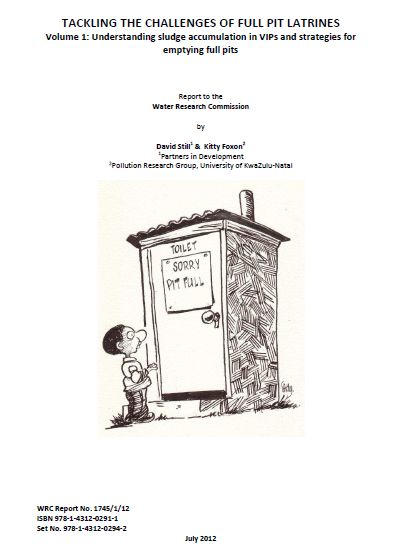Tackling the challenges of full pit latrines - Volumes 1 to 3
Still, D., Foxon, K., O’Riordan, M. (2012)

Published in: 2012
Publisher:
WRC Report No. 1745/1/12, Water Research Commission, South Africa
Author:
Still, D., Foxon, K., O’Riordan, M.
Uploaded by:
SuSanA secretariat
Partner profile:
common upload
40306 Views
2598 Downloads
Content - Summary
Volume 1: Understanding sludge accumulation in VIPs and strategies for emptying full pits
The task of providing adequate sanitation does not end with building toilets. On-site systems will eventually reach capacity and if a long-term plan for their maintenance, supported by a budget, is not in place, full toilets will become unusable and households will be effectively without basic sanitation once again. Water Services Authorities need urgently to assess the real requirements of the basic sanitation systems they have delivered and put plans, policies and budgets in place to maintain these systems if they are to avoid a sanitation crisis in the near future.
To date, additives currently being marketed to reduce pit filling have proven ineffective. While thepotential for significantly enhancing processes already occurring in the pit seems limited, there is a need
for standard methods to be established in order to investigate the effectiveness of new products. In the absence of this, municipal funds are better invested in proven methods of sludge removal.
The experience of municipalities, such as eThekwini, which have led the way in pit emptying has demonstrated that vacuum tankers are not always effective for maintaining VIP systems. The development of more appropriate technologies shows promise and prototypes designed during this research provide a strong basis for further development.
The presence of waste in the pits of toilets represents an enormous obstacle to effective pit emptying. Placing a high priority on instituting and maintaining reliable solid waste collection programmes will go a long way to solving this problem.
Sludge removed from a pit represents a resource, in terms of its nutrient content. Every effort should be made to utilise it beneficially rather dispose of it as a waste.
++++++++++++
Volume 2: How fast do pit toilets fill up? A scientific understanding of sludge build up and accumulation in pit latrines
Previous studies of on-site systems indicate a wide range of accumulation rates for wet (septic tank) systems (22 ?/c.a to 95 ?/c.a) as well as for pit latrines (19 ?/c.a to 70 ?/c.a). Filling rates for pit latrines observed in this study ranged from 21 ?/c.a to 64 ?/c.a. It was found that pits typically filled at a rate ranging from 200 ?/annum to 500 ?/annum regardless of the number of users. For pit design, using a figure of 40 ?/c.a meets household requirements, while basing pit emptying programmes on a figure of 60 ?/c.a ensures that pits do not reach capacity before the commencement of the planned emptying cycle.
Some municipalities have turned to products marketed to slow or halt accumulation in the pit in the hope that this will significantly reduce the frequency at which they will need to be serviced or eliminate
the need altogether. In order to investigate the efficacy of these products, the Water Research Commission has tested approximately 20 pit additives in field and laboratory trials. To date none have been found to be effective in reducing pit filling rates. It is vital that municipalities do not spend their sanitation budgets on products with no proven benefit, leaving inadequate funds to service their onsite
sanitation systems with tried and tested methods when these products fail.
Few municipalities have been proactive to date in terms of developing sanitation management programmes which integrate pit design and pit maintenance and where pit filling is monitored. As a result, many are likely to face a critical situation in the near future when pits reach capacity and they are ill prepared to respond. It is imperative that municipalities put programmes in place which are based on a sound understanding of the behaviour of users, geophysical characteristics of the area and system design so that they can manage the maintenance of systems efficiently and without compromising public health.
+++++++++++++++++
Volume 3: The development of pit emptying technologies
This report presents the design, development and testing of a number of prototypes of portable pit emptying technologies that were developed as part of Water Research Commission research project K5/1745.
The designs which have been explored to date have been the pit screw auger, which uses a motorised soil auger to lift sludge from a pit, the Nano Vac and e Vac, which use piston pumps and vane pumps to suck relatively wet sludge from pits. In addition, a pressure vessel has been
developed which can be used for collecting sludge or for pumping water or air into a pit to aid removal.
Being portable by two people these technologies do overcome the issue of access and have proven viable when trialled on pig slurry. The eVac has in addition been used successfully to empty wettish pit latrines in the field, which it does with little difficulty. Being the most robust and the most compact of the devices, the eVac appears to have the most potential on pit latrines in the field, and should be the focus for further research and development work.
++++++++++
Flyer: Do Pit Additives Work? (answer: no, they don't)
Bibliographic information
Still, D., Foxon, K., O’Riordan, M. (2012). Tackling the challenges of full pit latrines - Volumes 1 to 3. WRC Report No. 1745/1/12, Water Research Commission, South Africa
Filter tags
English Faecal sludge treatment processes Operation, maintenance and sustainable services (WG10) Peri-urban Recommended by SuSanA (other than SuSanA publications) Sub-Saharan Africa















